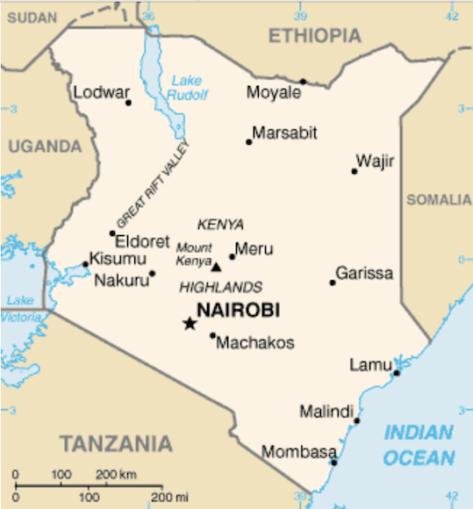In 1955, at the height of the Mau Mau Rebellion, my uncle John Alldridge produced a series of reports from Kenya for the Birmingham Mail and the Manchester Evening News – Jerry F

Kenya map from CIA World Factbook,
United States Central Intelligence Agency – Public domain
Vachakos
First among the African grievances is land-hunger. Had there been no such long-standing grievance among the Kikuyu — exaggerated and distorted though it was by subtle propaganda — there would certainly have been no Mau Mau.
For the Kikuyu, an intelligent tribe who have quickly adapted themselves to the white man’s way of life, still live very close to the soil.
Like the Irish and the Italian, the Kikuyu will work in cities far from his native reserve in the hope that one day he may return to rent and work his own plot of land.
It is one of the tragedies of East Africa’s history that when the white man began to settle in what is now known as the “white highlands” — 12,000 square miles of rich farmland set aside exclusively for European development — the land was empty.
A few years before the first settlers arrived the Kikuyu had suffered a series of appalling disasters — smallpox, rinderpest, drought, famine, locusts — which killed one in five and drove thousands of the survivors to live with relations and friends in the Nveri and Fort Hall districts, where the devastation had been less severe.
When the tribe began to recover it demanded the land which is now needed.
For this reduction of population did not in the least affect the ownership of the land.
By Kikuyu law and custom land was not and never had been held on a communal or tribal basis but was owned by individuals and by their families by right of inheritance.
And those who temporarily moved away looked forward to the day when they would return and develop their ancestral estate once more — even if that estate consisted of only a couple of acres of scrubland.
But by this time the white highlands had become sacrosanct, and today 4,000 Europeans are settled there, while all around them are the teeming populations of the African reserves, already filled to overflowing.
The settler’s case is a good one: his farm, which he has developed by energy and hard work, is his home.
He knows that much of the Africans’ trouble stems from an antiquated system of land tenure and primitive methods of farming which, by modern European standards, date back to the Middle Ages.
He is uneasily aware that the benefits of British rule have indirectly led to the great increase in the African population and it has been part of a clever anti-European campaign, fostered by such organisations as the Kenya African Union, deliberately to sabotage government projects designed to benefit the African.
Subversive elements in Kenya — and there are many, and not all of them African — are able to make great play with a Government White Paper of 1923, which stated categorically:
“Primarily Kenya is African territory and His Majesty’s Government thinks it necessary definitely to record their considered opinion that the interests of the African natives must be paramount and that if, and when, those interests and the interests of the immigrant races should conflict, the former should prevail.”
Though this uncompromising principle was later quietly abandoned, it remains the body which still haunts open-minded men of all colours and creeds.
It came vigorously to life during the present emergency, and it is to the eternal credit of the much-abused, much-harassed Kenya Administration that having recognised the danger at long last it has decided to do something about it.
The future policy of the Kenya Government towards African agricultural reform was swiftly summed up at the conclusion of a report made by Mr. R. J. M. Swynnerton, assistant director of agriculture, and published last May:
“The bulk of the African population lives in areas suitable to intensive or semi-intensive farming and the order of their contribution to the economy of the Colony should aim at raising the surplus from £10 or so per annum to £100 or more apiece.”
“The bulk of the 6M cattle in Kenya lie in the pastoral areas, in the main semi-arid. If the value … of 650,000 head can be raised from £2 to £10-£15 apiece, that gives some idea of the potential value of stock in those areas.”
“They are targets well worth making a decisive effort to achieve.”
It is heartening to see these complicated long-term projects already beginning to take shape.
It is, for instance, beginning to make headway among the Kikuyu, where one of the most complicated and confused systems of land tenure ever devised make it perfectly possible for one farmer to own several small pieces of land several miles apart.
To counteract this the Government has introduced a policy of land consolidation, which means, in effect, that a farmer may exchange his isolated plots for one consolidated holding of equivalent acreage, on a third of which he may plant “cash crops” — coffee, tea, pyrethrum — instead of the eternal alternatives of maize, beans, and wattle.
In one typical “itura” I visited in the Fort Hall district 220 people will be settled on consolidated holdings over an area of 1,200 acres.
In this particular block of land only 12 farmers were found to hold less than three acres, and 72 had over six.
Since six acres appears to be the limit on which a reasonable living can be obtained, the 12 with less than three acres will be encouraged to move into one of the new villages built during the emergency.
Each villager will be given a half-acre plot and an allotment, and 15 or 20 acres within the village will be set aside for community development such as schools, playgrounds, and community centres.
More important still, all African landowners will eventually be given land titles signed by the district commissioner in the name of the Crown, and the owner’s name and property recorded in what amounts to a village “Domesday Book.”
This is something for which the practically minded Kikuyu has been agitating for years.
Over here in the Machakos district in the untroubled areas south-east of Nairobi, I have seen an even more remarkable land revolution.
Machakos is the country of the Kamba, a sturdy, hard-working tribe who supply most of the recruits for the Kenya Police and the King’s African Rifles.
Eight years ago this was a dust-bowl. Mile after mile of parched earth. Gaunt hills without a square yard of vegetation. Between them Man and Nature had done their worst.
Today what you see is a picture of wooded hills, terraced farmhouses, and cheerful brick cottages. Cattle which once browsed on thorn scrub give more milk than the Kamba ever dreamed of.
Apples, peaches, and strawberries grow on hillsides which once repelled grass.
No miracle: just the courage and enterprise of a few white enthusiasts backed up by a handful of Kamba soldiers who returned from fighting in Abyssinia and Burma to be appalled at what had happened to their country in their absence.
A start was made in the Makueni area of southern Machakos, then covered with thick thorn bush and infested with rhino.
Government bulldozers cleared the bush: white hunters got rid of the rhino.
And, watching this white magic from the tops of their eroded hills, the Kamba began to lose their suspicion.
What 150 families at Makueni had done, they could do. And they did…
Two Englishmen take the credit for this scheme — District Commissioner John Howard and his successor, Douglas Penwill.
Penwill is another of those brilliant youngsters brought to the top by the emergency. The drive and energy of this 36-year-old Devonian are fast becoming a Kamba legend.
When he became a D.C. at the end of 1950 he told his staff: “Get to know the people. Live among them. Show them we’re not white magicians — just white friends.”
Thanks to Douglas Penwill and men like him, Mau Mau will never come to Machakos.
Reproduced with permission
© 2024 Newspapers.com
Jerry F 2024



